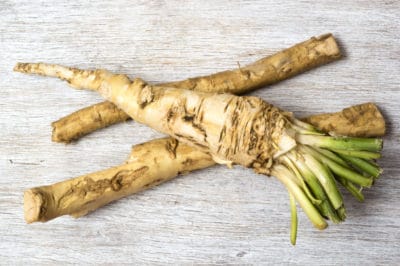Horseradish is a Spreader
Horseradish operates on the principle that if a little is good, a lot is better. The peppery roots are constantly looking for ways to expand their territory. Luckily, seed is usually sterile. On the rare occasions when the seeds are viable, however, they can quickly take over an area and become a weedy nuisance.
Soil and Harvest
The quality of your soil has a big impact on your ability to grow and harvest horseradish. Loose, friable soil gives the roots room to spread. It also makes it easier to dig the roots and to sift through the soil to find all the small pieces of root. A sandy loam is ideal, so add sand and humus in the form of well-rotted leaves to heavier clay soils.
Choose Your Tools
You have to get the roots out of the ground, both to use them and to keep them from spreading. A shovel is not the ideal tool as it can slice roots and leave small pieces in the ground to grow into new plants. A digging fork works better and makes it easier to allow soil to fall off so you can see the roots.
Container Advantages
Growing horseradish in containers is the best way to control their spreading habit. It also makes harvest very easy – just turn the container upside down on a hard surface. Make sure your container is at least two feet in diameter and three feet deep. Flaring sides with a narrow bottom and wider top make it easier to get the root ball out of the container.
Harvest – Best Practices
Here’s a quick summary:
- Grow horseradish in loose, friable soil.
- Harvest in fall and early winter for best flavor.
- Water well a day prior to harvest.
- Use a digging fork, not a shovel.
- Carefully sift soil with your hands to get all the root pieces out.
- For easiest harvest and to prevent spreading, grow horseradish in containers.
Don’t Forget the Seeds
Some horseradish seeds are viable. If you grow your plants as perennials, they will typically set seed in summer. Ideally, you should cut off the flowering stalks before they ever produce seed. Otherwise, cut off the seeds before they are fully developed. Do not place them in the compost pile; if even one or two seeds are viable, you may have a problem.
